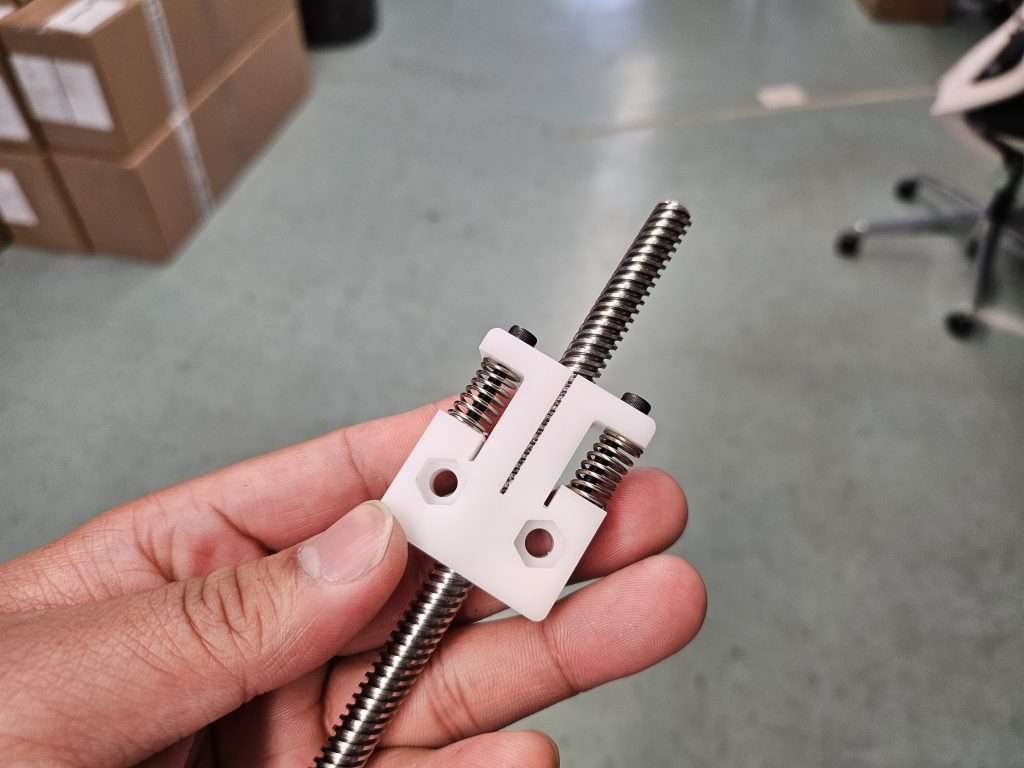Hi everyone, I’m excited to share a small development, the Spring Loaded Anti-Backlash Nut! As we’ve continued to have LongMills out in the wild, we’ve recognized that the finickiness of the Delrin Anti-Backlash Nut was a pain point for our users, such as the need for adjustment on a regular basis, the potential for the adjustment screw to fall out, and improper tensioning causing jamming, especially at higher speeds.
The Spring Loaded Anti-Backlash Nut is designed to address these issues by using a set of springs to tension the nut against the threads radially, allowing smoother operation and no adjustment needed from the operator. We are now putting this out into the wild for field testing!
These nuts are drop-in replacements for any T8 size Delrin nut on the MK1 or MK2 LongMill.

This new version is now available on sale and ready to ship in our store.
Flaws with the current Delrin Anti-Backlash Nut
For those who don’t know, the Delrin Anti-Backlash Nut design comes from the original Openbuilds Anti-Backlash Nut Block. At the time, this was more or less the best option for this type of hobby CNCing for T8 lead screws because it’s:
- Inexpensive
- Simple
- Easy to manufacture
- Easy to integrate
- Low maintenance
- Generally works pretty well
Since we were still in the early stages and didn’t have the manufacturing volume and capability to make our own designs at scale, we stuck to a lot of open-source and off-the-shelf components. As some users may have noticed, we’ve slowly been working on different innovations to improve and redevelop our own components to work better and more reliably.
The original design comes with a couple of flaws:
- Requires constant adjustment to reduce backlash
- Over-adjustment or incorrect assembly results in binding
- Inconsistent resistance during its life cycle
To improve on this design, I worked on some different concepts using springs to pre-load the nuts, finally resulting in this shape:
“This design incorporates OpenBuilds, LLC design work(s) shared Open Source under the CC BY-SA 4.0 License.”
In this design, we use two springs in the gaps to apply radial preload on the lead screw threads. This allows the two “arms” to push into the threads as it wears, automatically reducing the backlash.
According to Helix Linear, another manufacturer for anti-backlash nuts, “the radial anti-backlash nut can handle loads greater than the spring force. There is also less of an increase in required drive torque compared to an axial anti-backlash nut.”
In this design, we use two arms instead of three typically used in industrial nuts, to keep the same form factor, so that the new nut can drop in to replace the current version with no modification.
Other benefits include:
- Zero adjustments or maintenance after installation
- Lower potential for binding
- Smoother, lower resistance operation
Next steps
We’ve done some initial testing with 3D-printed nylon nuts, which have pretty good results, showing basically no backlash over testing. We’ve now ordered 400pcs (100 sets) of machined Delrin nuts. Our goal is to put them available for sale for people to use on their own machines. If they work well in the field we will switch to spring-loaded nuts as the default standard in LongMill kits.
I should include a disclaimer, which is that these are still a new, unproven product, and it is still possible that in the long term they may perform worse than the original nut.
We want to put these nuts out in the field so that we can get feedback and long-term testing done to validate the design. I’m very confident that this will make an improvement to the overall experience of using the LongMill, but before we make the switch, we want to make sure that we do some real-life testing.
There may be some small tweaks we may consider making, such as adjusting the spring force and length and spacing of the arms, which may happen based on the beta testing.
For this first batch of nuts, we will collect some survey data to help understand the experience of the user. At this current stage, we only have T8-size nuts, but we may expand it to the T12 size as well.